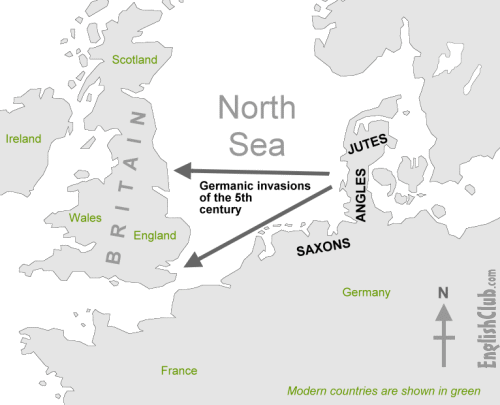A REVIEW:
1 - A brief history of the origins of English:
The history of the English language really started with the arrival of three Germanic tribes who invaded Britain during the 5th century AD. These tribes, the Angles, the Saxons and the Jutes, crossed the North Sea from what today is Denmark and northern Germany. At that time the inhabitants of Britain spoke a Celtic language. But most of the Celtic speakers were pushed west and north by the invaders - mainly into what is now Wales, Scotland and Ireland.

fonte: http://www.englishclub.com/english-language-history.htm
In the first chapter of this video talking about the history of English language, it is a good start to understand the origin of the modern words we use today:
2 - OLD ENGLISH :
BEOWULF
The Old English language, also called Anglo-Saxon, was the earliest form of English. It is difficult to give exact dates for the rise and development of any language, because changes in languages do not occur suddenly. However, Old English was in use from about 600 AD to about 1100.The greatest Old English poem is Beowulf, which belongs to the seventh century. It is a story of about 3,000 lines, and it is the first English epic (a story in poetry of the adventures of a brave man or men). The name of its author is unknown.
fonte: http://www.anglik.net/oldenglish.htm
BEOWULF
This presents a summary of the poem:
3 - MIDDLE ENGLISH:
GEOFFREY CHAUCER
Geoffrey Chaucer(1343 – 25 October 1400), is considered the greatest English poet of the Middle English Period. He was an author, philosopher, alchemist and astronomer. Some of his works include The Book of the Duchess and The House of Fame, but he is best known worldwide for the famous The Canterbury Tales.
4 - EARLY MODERN ENGLISH - THE TRANSITION:
a) Boundaries of time and place
The early modern English period follows the Middle English period towards the end of the fifteenth century and coincides closely with the Tudor (1485–1603) and Stuart (1603-1714) dynasties. The battle of Bosworth (1485) marked the end of the long period of civil war known as the Wars of the Roses and the establishment of the Tudor dynasty under Henry VII (1485–1509), which brought a greater degree of stable centralized government to England. Not long before, the introduction of the craft of printing in 1476 by William Caxton marked a new departure in the dissemination of the written word.
b) Variations in English
During the Middle English period numerous regional dialects existed in England and Scotland. Middle English manuscripts, even copies of the same work, differ linguistically from one another to a greater or lesser degree. In the later Middle Ages London gradually emerged as the seat of administration and the court. The speech of the capital acquired social prestige and written forms of it became usual in official documents and literature, though it could only loosely be called a ‘standard’. Since printing was based in London this form of English was adopted by the early printers. But Caxton himself was acutely aware of variation and change within English.








